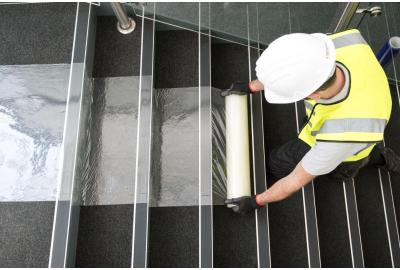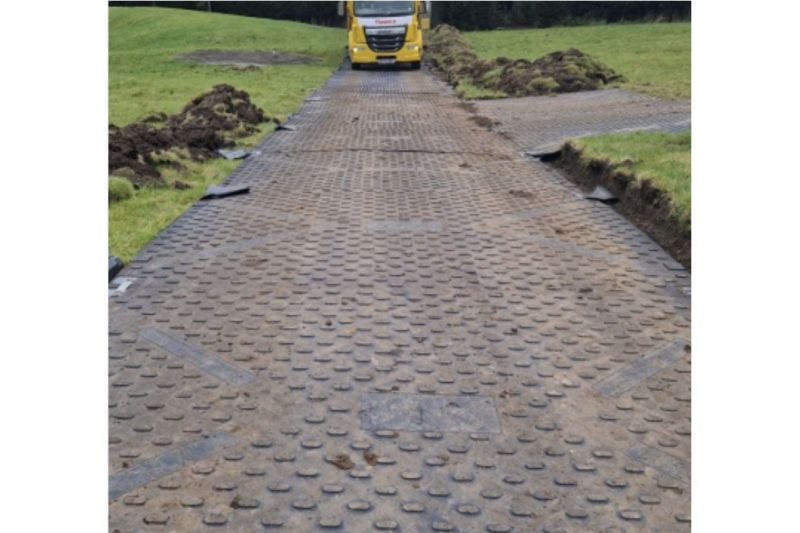No matter whether you are working on a complete renovation or a minor construction project, it is vital that you are protecting the surfaces in a customer's home.
This is especially true when you are protecting delicate finishes such as paint, tiles, and polished surfaces, as it is crucial to prevent any damage during the work you are carrying out.
Various methods of surface protection exist for construction and remodelling, and selecting the appropriate one for your undertaking depends on multiple factors, such as surface type and the extent of the construction work.
In this guide, we take a look at a variety of temporary protection solutions for delicate finishes.
The best temporary surface protection for delicate finishes
- Floor protection boards
- Polythene sheeting and films
- Foam tiles and padding
- Dust Sheets
- Protective tapes
- Edge protectors
Floor protection boards
Correx floor protection boards are a popular choice for protecting delicate finishes. These lightweight corrugated plastic boards are quick and easy to use, are very durable, and can be reused.
From refurbishments to redecorating, these boards are tear, puncture and impact resistant. They can be used as a temporary protection on any job as they help to protect your floors from knocks, scratches and spills.
The Correx boards are generally used for floor protection, but they can be cut, curved, and creased to fit any surface. They have also been used to protect stairs, doors, and walls.
To use the Correx floor protection, you need to make sure that there isn’t any rubble on the floor before you lay it down. Once the boards are in place, you can cut them with a safety knife and join them together with tape.
Polythene sheeting and films


Polythene sheeting and films are now manufactured in all sizes and thicknesses, so you can pick one to suit your needs. Being such a versatile material, it has many benefits when used on your construction site.
It can be used as a temporary dust screen and the material is flexible so that it can be draped or hung over furniture or floors. Polythene can easily be cut with a knife so it can fit different shapes and spaces on a construction site.
There are polythene sheets that are fire retardant and others which are waterproof, meaning they are used for a variety of different projects, including protecting delicate finishes.
Foam tiles and padding
Foam rolls or interlocking foam tiles can be used to protect delicate flooring, such as hardwood, and debris which is produced as a result of drilling or other types of work.
They are particularly useful in areas of a construction site where there is a lot of footfall and around heavy machinery.
Foam tiles are durable and hard-wearing, but what makes them a good choice for many construction workers is they are quick to lay. Their soft-touch finish means that they can be used to protect marble or stone floors.
Dust Sheets
Dust sheets are essential for covering furniture, walls, floors, kitchen units and other large surface areas to protect them against dust, paint, and fine debris during sanding or painting jobs.
There are a variety of different types of dust sheets, and here we take you through the most popular choices:
- Cotton Twill dust sheets: They are very versatile and are made from 100% cotton. They are perfect for decoration projects.
- Stair dust sheets: Made to cover all types of staircases and with no fixing required, this type of dust sheet can be used to protect a carpet or wooden staircase when you are sanding, painting, or drilling.
- Waterproof dust sheets: Backed with polythene, this dust sheet is completely waterproof, and it will stop any liquid from leaking through onto the surface that it is protecting below.
Protective tapes
If you want to protect windowsills, trims or other narrow surfaces, then you will need to use protective tapes such as painters or stucco tape.
These specialist types of tape mean that once you have finished the work you are doing, they can be easily removed, and they will not leave adhesive residue.
At Beck, we have a variety of different tapes available such as easy tear low-tack PVC tape, which is ideal for joining protection materials such as protection boards together, or the self-adhesive aluminium tape, which is commonly used in the construction industry for pipe lagging.
Edge protectors


As the name suggests, Edge Protectors are perfect for protecting the corners and edges of walls, countertops, and furniture during construction work. Most edge protectors are made from foam or plastic, and they are easy to install before carrying out a job or removing once a job has been completed.
It is common for wall edges or counter tops to be chipped or marked during a construction work, but with an edge protector it means you don’t have to worry about damaging a customer’s home.
The products in this guide are designed to protect different types of surfaces, so it is important that you choose a product that is best suited to the job you are doing and the surfaces that need covering. Here at Beck, we specialise in providing temporary protection products to help protect surfaces and construction workers.
Browse our range of Proguard products or get in touch with any questions.
For more tips, guides, and advice, visit our news page.










